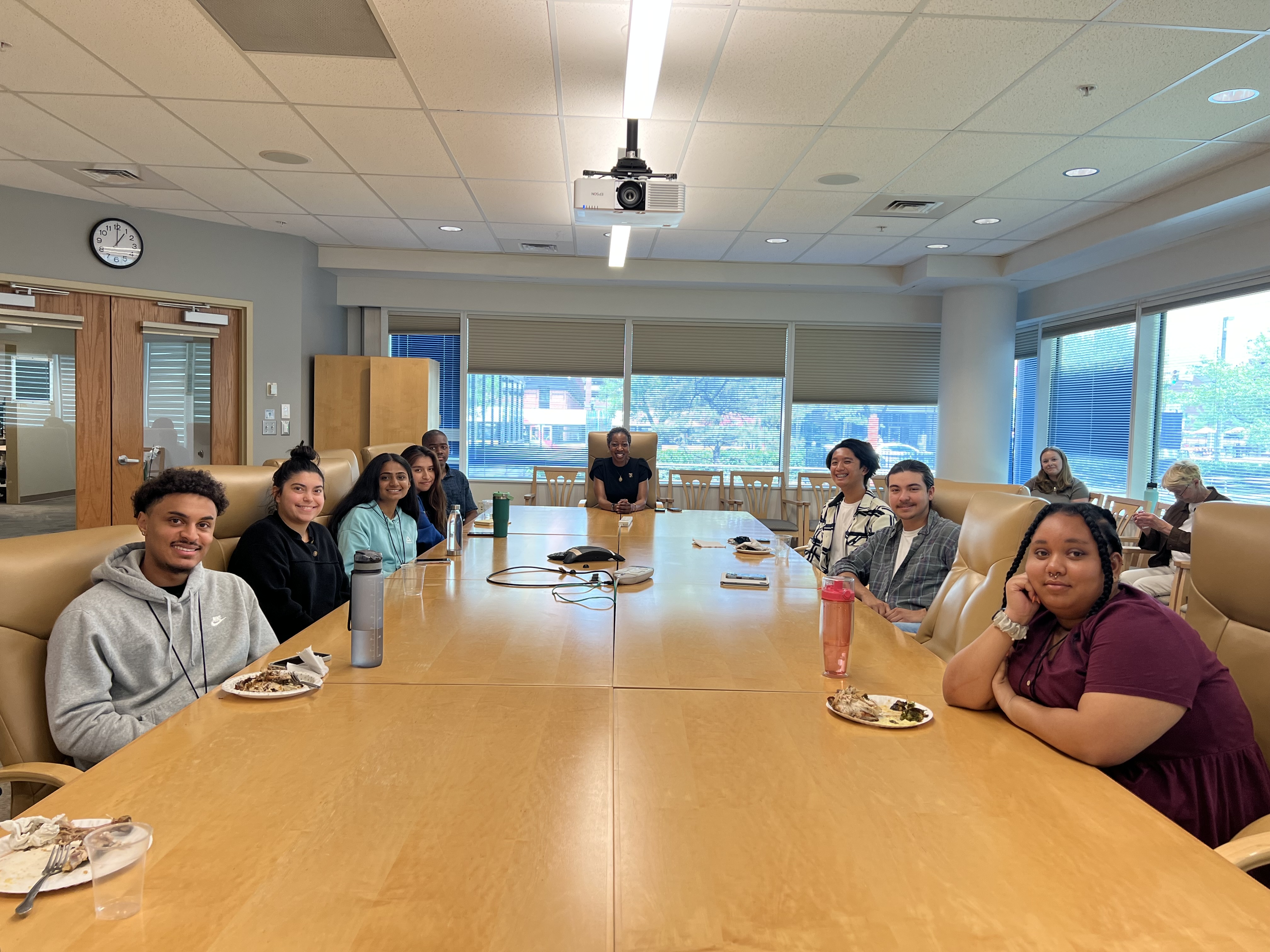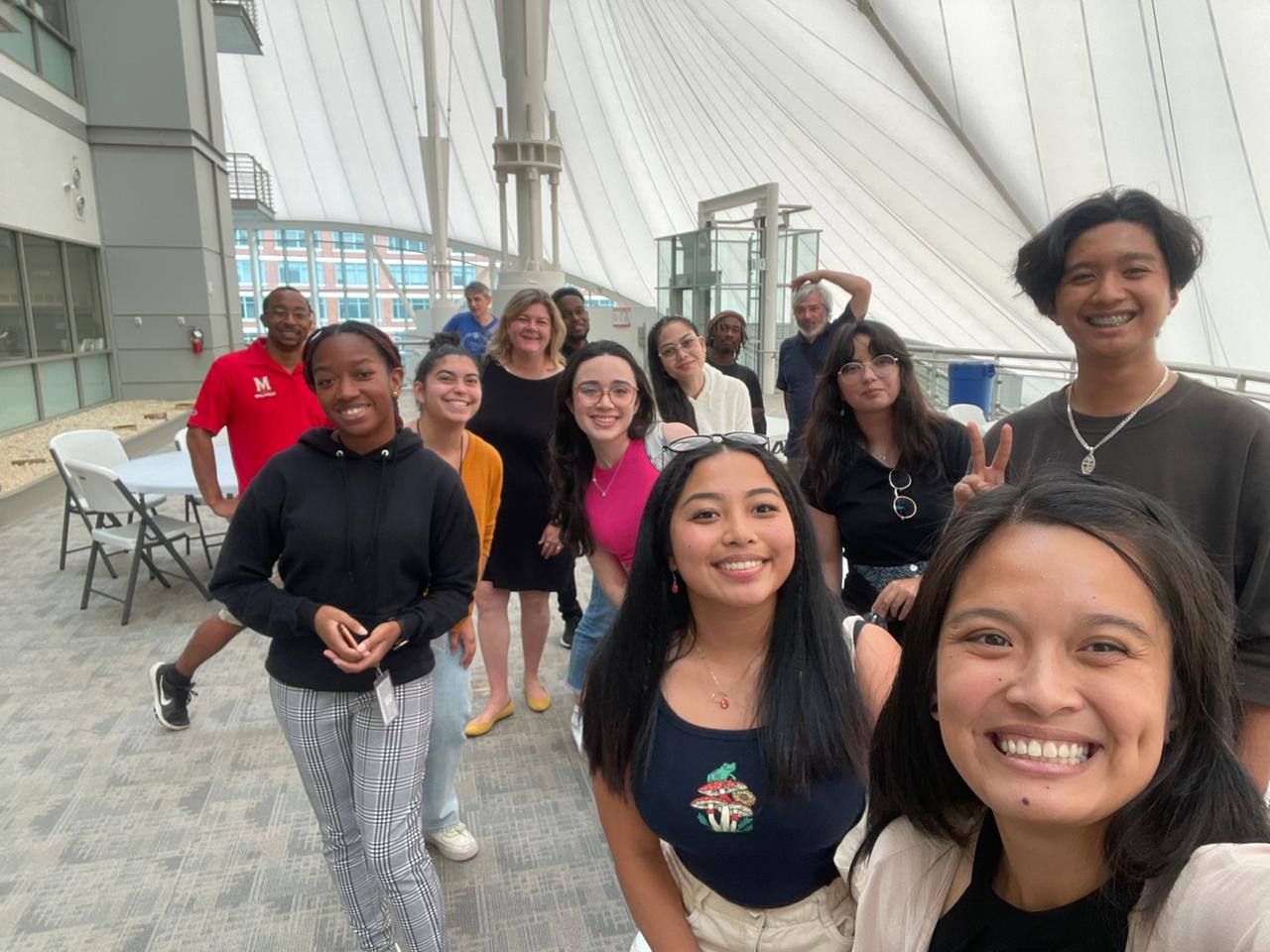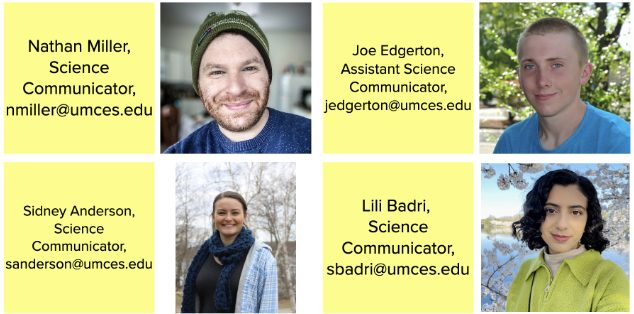Week 1: Let’s Dive In
Meet Our Interns:
IMET Mentor: Allyson Kido, MS student
Week 2: Getting Comfortable
Danielle Ferguson is an intern in the lab of Dr. Allen Place. With the help of her mentor, PhD student Emily Jolly, and lab mates, Danielle is exploring the microbiome of land-based aquaculture-raised fish being fed alternative diets. The goal of land-based aquaculture is to protect the oceans and marine life while continuing to feed our growing population. However, despite the fact that fish raised in land-based aquaculture units are not coming from the oceans, their food still is. Fish meal is typically made from small oceanic fish. If our goal is to protect the oceans, then we need to find a way to feed aquaculture-raised fish without pulling their food from the sea. That’s where Dr. Place’s lab comes in. The Place lab is exploring alternative protein sources for fish feed. These options could include pellets made from insects or algae. However, we need to understand how these ingredients impact the fish before using this idea more extensively. That’s where Danielle comes in. Danielle’s project is focused on exploring the microorganisms living within these fish to see what impacts alternative diets have on aquaculture-raised fish and their microbiome.
All of our interns have fascinating research projects ranging from dinoflagellate toxins to optimal growing conditions for mussels in Baltimore’s Inner Harbor and so much more! You will be able to read about each project in next week’s blog.
This week at the Friday session, the interns met with Keith Snipes. His experience as an actor, poet, and vocalist make him an unconventional yet innovative mentor. He is eloquent, open, and very personable. To start off their session, the interns got to practice describing their research projects to Keith in a way that was accessible and engaging. After these introductions Keith spoke about the concept of “imposter syndrome”. Together, he and the interns defined imposter syndrome as the belief that you do not belong in an environment despite your past successes. They discussed where this feeling comes from and the importance of rewriting the narrative happening in your mind. IMET employee, River Segreto joined the interns in this discussion and shared her belief in the benefits of “thought training”. She explained that she is consistently working on stopping the negative thoughts from running wild in her brain. She redirects her thinking or activity whenever this happens and overtime she has seen the negative thoughts start to quiet. Thank you to Keith and River for such wonderful advice and discussion. See you soon for week 3 of the IMET Summer Internship Program!
Week 3: New Friends
In addition to learning more about the science they will be working on this summer, the interns had a wonderful Friday session with our friends at Baltimore Gas and Electric (BGE). BGE is an Exelon company that provides gas and electric services to more than 1.2 million customers in Maryland. BGE supports the local community, sustainability efforts, and green energy. They are also a generous supporter of the IMET Internship Program. Seventeen BGE interns along with leadership staff members including BGE President & CEO Carim Khouzami, Senior Vice President of Government, External, and Regulatory Affairs Alex Nuñez, and Director of Corporate Community Impact Tanya Terrell, spent the day interacting with our interns and learning more about IMET. Their day included tours of IMET laboratories and the Aquaculture Research Center, talks by IMET Director Dr. Russell Hill, BGE President & CEO Carim Khouzami, and IMET faculty member Dr. Yantao Li, and a delicious lunch with even better conversation. Together the interns got to share their internship experiences with one another, learn more about IMET and BGE’s environmental sustainability and conservation efforts, and practice their networking skills.
Avani Patel
Marlon Waits
Nathan Paz
Noah Mansfield
Danielle Ferguson
Charles Cutignola
Braxton Kess
Elizabeth Rojas
Week 4: The Beauty of Not Knowing
Week four was the busiest week yet. Between lab experiments and meetings with their mentors the interns attended multiple events throughout the week:
Tuesday: A visit with President Sheares-Ashby

Wednesday: SEAS Islands Alliance Tour

Thursday: IAN Science Communication Training
Friday: IMET Picnic
Week 5: Science In Design

Week 6: Exploring your Options
During her master’s degree, she spent a summer interning with the National Park Service in California where she studied reptiles and amphibians in and around the Santa Monica Mountains. Her research involved analyzing data collected over several years to estimate population size, survival mechanisms, and other factors for various species.
Pursuing a Ph.D. was not her initial goal, but with the support of her peers, mentors, and the organizations she worked with, she decided to pursue it. She enrolled in the Integrative Conservation Program, a multidisciplinary program combining ecology, forestry, anthropology, environmental education, and marine biology. For her Ph.D. funding, she obtained a prestigious National Science Foundation Graduate Research Fellowship (NSF-GRFP).
After obtaining her degree, Dr. Miles realized that the urban/wild interface was where she could make the most impact. She stressed to the interns that this realization came from a long line of opportunities where she was able to try on different hats. She encouraged them to explore memberships in societies or organizations relevant to their interests as a way to stay connected to people who can help keep them motivated and stimulated. She also stressed the importance of voting and creating meaningful change.
Other highlights from the week! The interns have been exploring Baltimore city and the surrounding areas. A group hopped over to Camden Yards on Friday to watch the Orioles beat the Marlins 5-2!
Week 7: The Riverkeeper
Fred’s discussion with the intern group talked as much about family heritage as it did about River Keeping work. Fred has significant family connections with Baltimore. His uncle, Henry Hall, was one of the founders of the National Aquarium in Baltimore. Additionally, one of his ancestors was the founder of the Matthew Henson society, celebrating the achievements of the polar explorer Matthew Henson.
Week 8: Our Streets are Our Streams
With the end of their internship in sight, the interns spent the week finalizing their experiments, analyzing their data, and working on their final presentations. The interns could be seen in our conference rooms and lunch areas creating and practicing their presentations with one another. After working so hard this week, we brought in an incredible speaker to meet with the interns. Alice Volpitta, from Blue Water Baltimore, came to IMET on Friday and gave a presentation on her work as the Baltimore Harbor Waterkeeper. Alice protects the Baltimore Harbor, speaks on behalf of the people who live around the harbor, and takes legal action against polluters, including Baltimore City itself.
Blue Water Baltimore is a non-profit organization that cares for Baltimore’s rivers, streams and Harbor through science, education, and legal advocacy. Blue Water Baltimore monitors the environment by collecting and analyzing water samples from the Baltimore area. Using this data, environmental observations, collaborations, and feedback from the community, Blue Water Baltimore protects our waterways through education and litigation. Alice explained that legally, “waterways don’t belong to anyone, they belong to everyone”. If someone is ruining your experience of the water you have the right to take legal action. This is covered under the federal Clean Water Act. Alice’s presentation today focused on one main point, that “our streets are our streams”.
Using many images and graphics, Alice described how sewage systems across the country are old and failing. In Baltimore specifically, the stormwater pipes run parallel to the sewage pipes. Due to their failing condition, the pipes have begun leaking into one another. Stormwater pipes run straight from the streets to our streams, therefore, anything entering these pipes also enters our streams, including sewage. Conversely, if heavy storms occur stormwater pipes become overloaded and leak into the sewage pipes. This excess water quickly overwhelms the pipes causing sewage to enter our groundwater, streets, waterways, and homes.
Week 9: Grand Finale
It is the last week of the IMET Summer Internship Program. Our interns have been a wonderful addition to our institute this summer and we will miss seeing them playing Uno in the lunchroom! This Friday our interns were joined by their families, mentors, and colleagues for a day to celebrate their research. Each intern presented their work to an in-person and remote audience at IMET. Let’s take a look at how much they learned!
Nathan Paz | Blue Blood: Structural Analysis of Limulus polyphemus Hemocyanin | Mentors: Dr. Sook Chung and Dr. Tsetso Bachvaroff
Noah Mansfield | Effects of Temperature and Salinity on Clearance Rate of the dark false Mussel, Mytilopsis Leucophaeata | Mentors: Allison Kido and Dr. Eric Schott
Noah’s research focused on the dark false mussel and its ability to reduce excess nutrients in the water column. In order to explore this ability he needed to better understand how dark false mussels are affected by salinity and temperature. Using samples pulled from the Inner Harbor, Noah monitored and compared the clearance rate (rate at which particulates are cleared by filtration) of dark false mussels at different temperatures and salinity levels. From this research, he concluded that temperature has a significant impact on the dark false mussel’s clearance rate while salinity does not have a significant impact. This is important to understand so we can determine if this is a viable solution for cleaning up harmful algae from the water column in the face of climate change.
Marlon Waits | Survey of Australian Algal Toxicity | Mentors: Emily Jolly, Dr. Al Place, and Dr. Tsetso Bachvaroff
Marlon’s research investigated different phytoplankton to determine whether they exhibited signs of toxic activity that would lead to a harmful algal bloom and fish/bivalve kills. Using 14 samples of phytoplankton isolated in Australia, Marlon set up an experiment to explore each phytoplankton’s lytic capabilities, or their ability to rupture a cell. His experimental results suggested the strains used in his research possessed no toxic activity. It is important to understand more about phytoplankton and its ability to cause harmful algal blooms as increasing global temperatures can lead to more frequent algal blooms.
Allison Shupp | Zebrafish galectin-1 (drgal1-L2) in Innate Immunity Against Bacterial Pathogens | Mentors: Muddassar Iqbal and Dr. Gerardo Vasta
Allison’s research focused on proteins called galectins and how they may reduce bacterial infection in aquaculture-raised fish. Galectins are shown to bind to bacteria but it is unclear how the galectins affect the hosts immunity. Allison’s research explored how zebra fish galectins bind to different pathogens to improve their immune response. It is important to understand the abilities of galectins to reduce bacterial infection as a way of reducing illness in aquaculture-raised fish.
Braxton Kess | Assay Development of a Novel Blue Crab Virus | Mentors: Jennifer Herrera and Dr. Eric Schott
Braxton’ s research focused on a virus impacting the blue crab population. In order to diagnose and prevent this virus from spreading there needs to be a new method of detection. Braxton’s research focused on creating a PCR test specific to this virus so diagnosis can occur faster. This research resulted in the development of a qPCR assay for the virus. The diagnosis of this virus is important for maintaining the health of Maryland’s fisheries which are highly dependent on the blue crab.
Charles Cutignola | Off-flavor Removal Technologies in Recirculating Aquaculture Systems | Mentors: Matthew Stromberg and Dr. Yonathan Zohar
Charles’ research focused on exploring new options for removing off-flavor in land-based aquaculture. Off flavor is an earthy or musty flavor that accumulates in fish raised in land-based aquaculture systems. The flavor is a result of the bacterial metabolite, geosmin. Charles’ research explored the ability of soybean wax to reduce geosmin concentration in water. His experiment resulted in 60% absorption of geosmin in the first three days of wax placement. In order to reduce our impacts on the oceans we need to find an alternative way to feed our growing population. Growing fresh fish in land-based aquaculture systems could be the solution.
Avani Patel | Gene Expression of Chaperone Proteins in Heat Shock Factor Mutant Zebrafish | Mentor: Dr. Jim Du
Avani’s research focused on the gene expression of different chaperone proteins in zebrafish. Chaperone proteins assist in the process of protein folding to ensure proteins function correctly. In response to stress, certain chaperone proteins called heat shock proteins are produced. Avani explored the role of heat shock factor 1 in the regulation of heat shock proteins during the stress response. Her research concluded that, under stress conditions the increase in expression of certain heat shock proteins is dependent on heat shock factor 1.
Danielle Ferguson | Effect of salinity on the blood chemistry of Atlantic Salmon (Salmo salar) grown in a recirculating aquaculture system (RAS) | Mentors: Dr. Al Place
Danielle’s research explored the difference in blood chemistry between salmon grown in freshwater and salmon grown in saltwater. To explore this Danielle collected and compared blood samples from salmon raised in freshwater tanks and salmon raised in salt water tanks. Danielle compared the metabolites found in the blood to determine the differences. Her research concluded that salinity does have a significant effect on salmon blood chemistry but the blood of both fresh and saltwater raised salmon remained healthy.
Elizabeth Rojas | Microalga Scenedesmus obliquus become resilient to salinity gradient when exposed to 10% CO2 | Mentors: Nick Gallagher and Dr. Feng Chen
Elizabeth’s research explored the effect of salinity on algae grown at high levels of carbon dioxide (CO2). Elizabeth grew the same strain of algae at various levels of salinity. She did two versions of this experiment, one in air and one in 10% CO2. Her research concluded that this strain of algae is able to grow under salt stress. However, its growth decreased at higher levels of salinity. The algae exposed to 10% CO2 was more resilient to salt stress than the algae grown in air. This is important to understand as climate change is caused by increased CO2 entering our atmosphere. Algae that uses high levels of CO2 to grow could be a solution to this problem.
- Our funders, whose support makes this program possible: Mary Catherine Bunting, the Venable Foundation, the Charles A. and Lois H. Miller Foundation, BGE, Maryland Sea Grant and the National Science Foundation
- The internship program faculty advisors: Dr. Eric Schott, Dr. Rosemary Jagus, and Dr. Tsvetan Bachvaroff
- IMET and UMCES Staff: Dr. Russell Hill, Sarah Hughes, Samantha Heyn, Sabreena Nazar, and Sam Sibanda
- UMCES Integration and Application Network Staff
- The workshop leaders, Keith Snipes and Dr. Kathleen Gillespie
- All our Friday guest speakers

